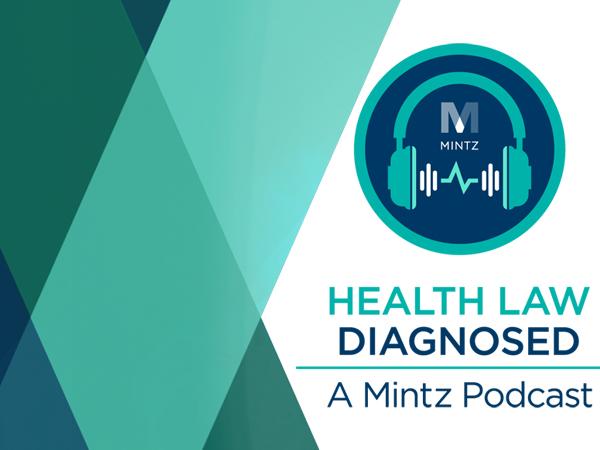
Health Care
Viewpoints
Filter by:
HIPAA Compliance in a National Emergency: What Does It Look Like in Real Life?
March 18, 2020 | Blog | By Dianne Bourque
Amidst the novel coronavirus (COVID-19) outbreak, the Secretary of the U.S. Department of Health and Human Services (HHS), Alex M. Azar, took steps on March 15, 2020, to waive sanctions and penalties related to certain provisions of the HIPAA Privacy Rule (the “Waiver”). However, the HIPAA Privacy Rule is not suspended, and the Waiver only applies: (1) in the emergency area identified in the public health emergency declaration; (2) to hospitals that have instituted a disaster protocol; and (3) for up to 72 hours from the time the hospital implements its disaster protocol. To demonstrate how the Privacy Rule and Waiver provisions work in real life, let’s look at an example: A patient at a hospital reports contact with a confirmed COVID-19 diagnosis. How can this information be shared?
Read more
FDA’s Ongoing Response to the COVID-19 (Coronavirus) Outbreak
March 18, 2020 | Blog | By Joanne Hawana , Benjamin Zegarelli
As we write this update on the actions of the Food and Drug Administration (FDA), more state and local governments (along with private businesses and employers) are taking sweeping actions to protect the public from the continued spread of COVID-19. The federal response to what is now a pandemic of COVID-19 started off slowly, but we are now seeing frequent and promising announcements from FDA and other agencies within the Department of Health and Human Services.
We published our first installment highlighting FDA’s role in this public health emergency on March 4, 2020 (see our prior post here). In the two weeks that have elapsed since then, FDA has taken several actions related to COVID-19 testing and other important public health protections which are explained below. One of the most striking things about the list of actions included in this post may be how diverse and broad FDA’s authorities are and what a substantial role the agency plays in protecting Americans from a variety of different types of harm.
Read more
We published our first installment highlighting FDA’s role in this public health emergency on March 4, 2020 (see our prior post here). In the two weeks that have elapsed since then, FDA has taken several actions related to COVID-19 testing and other important public health protections which are explained below. One of the most striking things about the list of actions included in this post may be how diverse and broad FDA’s authorities are and what a substantial role the agency plays in protecting Americans from a variety of different types of harm.
Congress Loosens Telehealth Reimbursement Restrictions in Response to Coronavirus, but State Law Practice Requirements Remain
March 17, 2020 | Blog | By Ellen Janos
Telehealth is going to play a critical role in the delivery of care in the coming weeks and months as health care providers respond to the COVID-19 pandemic. As the CDC and other public health agencies continue to recommend social distancing and self-quarantine after exposure, telehealth is a vital tool for getting both sick and healthy individuals access to health care services they need if in-person services are not necessary. The use of telehealth services should help alleviate the ever-growing pressures on health care systems as they respond to the outbreak. In light of these benefits, the Emergency Appropriations Bill passed by Congress last week includes provisions that allow the Secretary of Health and Human Services (HHS) to lift certain restrictions that are currently required for Medicare reimbursement of telehealth services.
Read more
Telemedicine and the Coronavirus Outbreak
March 13, 2020 | Video | By Ellen Janos
Ellen Janos discusses the role telemedicine is expected to play in the management of the coronavirus outbreak as well as the Emergency Appropriations Bill passed Congress which contains provisions intended to loosen the restrictions on Medicare reimbursement for telehealth services.
Read more
Third Circuit Rejects AseraCare’s “Objective Falsity” Requirement, Allows Scrutiny of Medical Opinions in Hospice False Claims Act Case
March 12, 2020 | Blog
Last week, the Third Circuit joined several other appellate courts in finding that medical opinions related to medical necessity of hospice services can be subject to scrutiny and found to be “false” for purposes of proving a violation of the False Claims Act (FCA) in U.S. ex rel. Druding v. Care Alternatives. Our Health Care Enforcement Defense Group has been closely tracking recent qui tam cases brought under the FCA based on allegations that health care services or procedures lacked the requisite medical necessity, including the conclusion of the landmark AseraCare case last week. As we’ve previously discussed on the blog, several district courts across the country have determined that differences of opinions between physicians and medical experts alone cannot be used to prove the FCA’s falsity requirement. However, some appellate courts have reached different conclusions. The Third Circuit’s decision last week in Care Alternatives joins those appellate courts in rejecting this argument and finding that “a difference of medical opinion is enough evidence to create a triable dispute of fact regarding FCA falsity.”
Read more
The VALID Act, Aiming to Reform the Regulation of Diagnostic Products, Is Finally Introduced in Congress
March 12, 2020 | Blog
Following years of discussion, on March 5, 2020, U.S. Representatives Larry Buchson (R-IN) and Diana DeGette (D-CO) and U.S. Senators Richard Burr (R-NC) and Michael Bennet (D-CO) introduced identical versions of the Verifying Accurate and Leading-edge IVCT Development (VALID) Act in both chambers of Congress. The bipartisan legislation closely tracks existing medical device laws, with some notable exceptions, discussed below and in a prior post. If enacted, many regulatory elements familiar to in vitro diagnostic (IVD) and other medical device manufacturers would be applied to clinical laboratories that develop their own tests, commonly known as laboratory developed tests (LDTs). The bill also includes elements that are priorities for the Food and Drug Administration (FDA), including a program conceptually similar to pre-certification, third-party review, and Collaborative Communities. Unlike previously-circulated discussion drafts, the introduced bills include specific language designed to address public health emergencies, including COVID-19.
Read more
Clinical Trial Results Will See Daylight After HHS Final Rule Is Set Aside
March 5, 2020 | Blog
Some clinical trial sponsors and principal investigators will be digging through their archives soon as a result of a recent ruling in the case of Seife v. U.S. Department of Health and Human Services, case number 1:18-cv-11462 (S.D.N.Y. 2018). In Seife, the plaintiffs – an investigative journalist and a former Associate Commissioner at the Food and Drug Administration (FDA) – challenged a Department of Health and Human Services (HHS) final rule that implemented clinical trial reporting requirements mandated by the Food and Drug Administration Amendments Act (FDAAA).
Read more
FDA’s Evolving Response to the COVID-19 (Coronavirus) Outbreak
March 4, 2020 | Blog | By Joanne Hawana
Within the U.S. Department of Health and Human Services (HHS), many agencies have responsibility for responding to public health emergencies. The Centers for Disease Control and Prevention (CDC), as its name implies, is at the forefront of the COVID-19 (coronavirus) outbreak as the government seeks to control and prevent the spread of the virus in the United States. The National Institutes of Health (NIH), particularly the National Institute of Allergy and Infectious Diseases, are also involved, primarily conducting research into the sources, cause, and means of transmission of the new virus and coordinating vaccine development efforts. The Food and Drug Administration (FDA) is responsible for assuring the safety and effectiveness of medical products and therefore has oversight over any clinical trials for promising coronavirus treatments (drugs, vaccines, devices), as well as authority to authorize the marketing of any such product. The agency oversees the drug supply chain and monitors drug and device shortages. This blog post covers steps that FDA has taken to mitigate potential drug and device shortages related to coronavirus and to otherwise respond to the coronavirus situation.
Read more
Landmark AseraCare Case Finally Ends in Settlement
March 2, 2020 | Blog | By Samantha Kingsbury, Brian Dunphy, Laurence Freedman
As many of our readers know, the AseraCare case was closely watched over the last several years because of its significance to efforts by the Department of Justice (DOJ) to allege that submission of claims for services lacking “medical necessity” violate the False Claims Act (FCA) as well as to efforts by providers to defend such cases. On Wednesday, we learned that the AseraCare case has reached its dramatic conclusion with an agreement to resolve $200 million in alleged damages for the agreed amount, as reported by AseraCare, of $1 million.
Read more
Collaborative Communities
February 27, 2020 | Video
ML Strategies’ Aaron Josephson explains why FDA is looking to Collaborative Communities to help solve challenges in 2020 and the potential benefit to companies who participate in the development of public policy.
Read more
CMS Proposes Significant Changes to Medicare Advantage & Part D for 2021 and Beyond, Part 2: CMS Proposes to Codify Supplemental Benefit Rules and Update MLR
February 25, 2020 | Blog | By Tara E. Dwyer, Lauren Moldawer
As a continuation of our series on the Contract Year 2021 and 2022 Policy and Technical Changes to the Medicare Advantage Program, Medicare Prescription Drug Benefit Program, Medicaid Program (the “Proposed Rule”) released by the Centers for Medicare & Medicaid Services (“CMS”) earlier this month, this blog focuses on CMS’s codification of its recent guidance on supplemental benefits, including guidance on Special Supplemental Benefits for the Chronically Ill (“SSBCI”). It also discusses CMS’s proposed changes to the medical loss ratio (“MLR”) to account for changes in supplemental benefits.
Read more
340B Ceiling Price Transparency – HRSA Now Requiring Pharmaceutical Manufacturers to Issue Refunds to Covered Entities for Overcharges
February 24, 2020 | Blog | By Daryl Berke
As regular readers of our blog know, the Centers for Medicare & Medicaid Services (CMS) intensified its push for drug pricing transparency in 2019. In 2020, we see a continuation of those efforts, and their impacts on the 340B program are now starting to reveal themselves. On January 1, 2019, the Health Resources & Services Administration (HRSA) finally implemented the ceiling price and manufacturer civil monetary penalties (CMPs) regulations that the agency proposed in 2017. The regulations implement certain provisions of the Affordable Care Act and were initially scheduled to go into effect on February 28, 2017, but were repeatedly delayed.
Read more
HHS Proposed Changes to AKS and Stark Law: Value-Based Arrangements
February 20, 2020 | Video | By Theresa Carnegie
Theresa Carnegie reviews both the OIG’s and the CMS’s proposed rules as they relate to the new value-based arrangements safe harbors and Stark Law exceptions.
Read more
HHS Proposed Changes to AKS and Stark Law: Patient Engagement and Support Safe Harbor
February 20, 2020 | Video | By Rachel Yount
Rachel Yount discusses the proposed new safe harbor that would protect patient engagement and support arrangements designed to improve quality, efficiency of care, and health outcomes.
Read more
Health Care Data Breaches Are Increasing Both in Number and Cost
February 20, 2020 | Blog
It feels like we’ve been seeing a lot more health care breaches caused by hackers and other IT security incidents recently, and there’s a good reason why: a recent report by cloud security company Bitglass confirms that both the number of breaches and individuals affected by breaches caused by hackers and IT incidents grew significantly last year. Bitglass analyzed data from the breach portal, affectionately known as the “Wall of Shame,” published by the U.S. Department of Health and Human Services (HHS) Office for Civil Rights (OCR). Pursuant to the HITECH Act, HHS is required to post a list of all reported breaches that affect 500 or more individuals. OCR classifies the types of breaches reported on the Wall of Shame, and the "Hacking/IT Incident" category includes a variety of breaches, including malicious intrusion, malware, ransomware, phishing, and general IT security failures.
Read more
Closing the Orphan Drug Act Loophole
February 18, 2020 | Blog
On Tuesday, February 11, 2020, Senators Bill Cassidy (R-LA), Jeanne Shaheen (D-NH), and Tammy Baldwin (D-WI) introduced legislation to eliminate the “orphan drug loophole.” Current law allows the Food and Drug Administration (FDA) to grant seven years of market exclusivity to a drug manufacturer if the drug is intended to treat a disease or condition affecting fewer than 200,000 patients in the U.S., or less commonly, if the manufacturer cannot expect to recover the costs of developing and marketing a drug. In some cases, even if the drug developer meets the orphan drug criterion of having no hope of recovering the costs, the drug does actually become profitable—some significantly so—but competitors are still barred from entering the market with a lower-cost alternative during the 7-year exclusivity period that exists by operation of law. To combat this issue, the recently introduced Senate bill (as well as a nearly-identical House bill introduced in October 2019) targets a loophole that allows market exclusivity under the Orphan Drug Act to be extended for future versions of the same drug without the drug's manufacturer having to show that the drug remains unprofitable.
Read more
FDA User Fee Agreements
February 14, 2020 | Video
In this video, Aaron Josephson discusses FDA user fee agreements, the timeline for the reauthorization process, and why it is important for companies with FDA-regulated products to be paying attention now.
Read more
CMS Proposes Significant Changes to Medicare Advantage & Part D for 2021 and Beyond, Part 1: Updates to the Star Rating System and Suspension of the Past Performance Methodology
February 13, 2020 | Blog | By Tara E. Dwyer, Lauren Moldawer
In CMS’s recently released proposed rule (the Medicare and Medicaid Programs: Contract Year 2021 and 2022 Policy and Technical Changes to the Medicare Advantage Program, Medicare Prescription Drug Benefit Program, Medicaid Program, Medicare Cost Plan Program and Programs of All-Inclusive Care for the Elderly) (the “Proposed Rule”) and supplemental HPMS memos, CMS is proposing several significant changes to its star rating system and to its methodology for reviewing plan past performance. This blog post highlights the key details of the proposed changes to the star rating system and past performance methodology and their potential impact on Medicare Advantage and Part D plans.
Read more
Friendly Reminder: HIPAA Still Applies During the Coronavirus Outbreak
February 12, 2020 | Blog
As the coronavirus remains to be an active outbreak with cases increasing within the United States, this is a good time to review how HIPAA applies in a public health emergency, including its restrictions and flexibility in these types of situations. Accordingly, last week, the Office for Civil Rights (OCR) released a helpful bulletin on how the HIPAA Privacy Rule comes into play with the coronavirus outbreak and other public health emergencies.
Read more
HHS Proposed Changes to Anti-Kickback Statute and Stark Law
February 10, 2020 | Video | By Karen Lovitch , Theresa Carnegie
Karen Lovitch, Chair of Mintz's Health Law Practice, and Theresa Carnegie, a Member in the Health Law Practice, discuss the proposed changes to the Anti-Kickback Statute (AKS) and Stark Law issued by Department of Health & Human Services (HHS) and dive into some of the key issues.
Read more
Explore Other Viewpoints:
- Data Centers & Digital Infrastructure
- AI: The Washington Report
- Antitrust and Federal Regulation
- Appellate
- Arbitration, Mediation & Alternate Dispute Resolution
- Artificial Intelligence
- Awards
- Bankruptcy & Restructuring
- California Land Use
- Cannabis
- Class Action
- Complex Commercial Litigation
- Construction
- Consumer Product Safety
- Corporate Governance (ESG)
- Cross-Border Asset Recovery
- DEI Legal Developments
- Debt Financing
- Direct Investing (M&A)
- Diversity
- EB-5 Financing
- Education & Nonprofits
- Employment
- EnforceMintz
- Environmental (ESG)
- Environmental Enforcement Defense
- Environmental Law
- Environmental, Social, and Corporate Governance (ESG)
- FDA Regulatory
- False Claims Act
- Federal Circuit Appeals
- Financial Institution Litigation
- Government Law
- Growth Equity
- Health Care
- Health Care Compliance, Fraud and Abuse, & Regulatory Counseling
- Health Care Enforcement & Investigations
- Health Care Transactions
- Health Information Privacy & Security
- IP Due Diligence
- IPRs & Other Post Grant Proceedings
- Immigration
- Impacts of a New US Administration
- Insolvency & Creditor Rights Litigation
- Institutional Investor Class Action Recovery
- Insurance & Financial Services
- Insurance Consulting & Risk Management
- Insurance and Reinsurance Problem-Solving & Dispute Resolution
- Intellectual Property
- Investment Funds
- Israel
- Licensing & Technology Transactions
- Life Sciences
- Litigation & Investigations
- M&A Litigation
- ML Strategies
- Managed Care
- Medicare, Medicaid and Commercial Coverage & Reimbursement
- Mergers & Acquisitions
- Patent Litigation
- Patent Prosecution & Strategic Counseling
- Pharmacy Benefits and PBM Contracting
- Portfolio Companies
- Privacy & Cybersecurity
- Private Client
- Private Equity
- Pro Bono
- Probate & Fiduciary Litigation
- Products Liability & Complex Tort
- Projects & Infrastructure
- Public Finance
- Real Estate Litigation
- Real Estate Transactions
- Real Estate, Construction & Infrastructure
- Retail & Consumer Products
- Securities & Capital Markets
- Securities Litigation
- Social (ESG)
- Special Purpose Acquisition Company (SPACs)
- Sports & Entertainment
- State Attorneys General
- Strategic IP Monetization & Licensing
- Sustainable Energy & Infrastructure
- Tax
- Technology
- Technology, Communications & Media
- Technology, Communications & Media Litigation
- Trade Secrets
- Trademark & Copyright
- Trademark Litigation
- Unified Patent Court (UPC)
- Value-Based Care
- Venture Capital & Emerging Companies
- White Collar Defense & Government Investigations
- Women's Health and Technology




